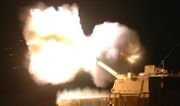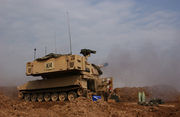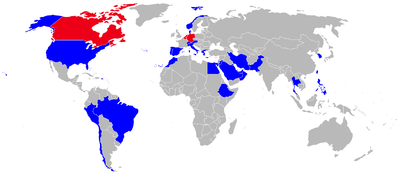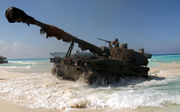M109 howitzer
| M109 Howitzer | |
|---|---|
M109 self-propelled howitzer of the Israel Defence Forces |
|
| Type | Self-propelled artillery |
| Place of origin | |
| Specifications | |
| Weight | 27.5 tons |
| Length | 30 ft (9.1 m) |
| Width | 10.3 ft (3.1 m) |
| Height | 10.7 ft (3.3 m) |
| Crew | 8 (Gun Commander, Driver, 6 x Gunners) |
|
|
|
| Shell | separate loading, bagged charge |
| Caliber | 155 mm |
| Breech | interrupted screw |
| Traverse | 360° |
| Rate of fire | 4 round/min maximum, 1 round/min sustained |
| Effective range | 18,000 m - 30,000 m (with rocket-assisted projectile) |
|
|
|
| Primary armament |
M126 155 mm Howitzer |
| Secondary armament |
.50 caliber (12.7 mm) M2 machine gun |
| Engine | diesel 8V71T 450 hp |
| Power/weight | 18.7 hp/t |
| Suspension | torsion-bar |
| Operational range |
216 mi (350 km) |
| Speed | 35 mph (56 km/h) |
The M109 is an American-made self-propelled 155 mm howitzer, first introduced in the early 1960s. It was upgraded a number of times to today's M109A6 Paladin. The M109 family is the most common Western indirect-fire support weapon of maneuver brigades of armored and mechanized infantry divisions.
The M109 has a crew of six: the section chief, the driver, the gunner, the assistant gunner and two ammunition handlers. The gunner aims the cannon left or right (deflection), the assistant gunner aims the cannon up and down (quadrant). The M109A6 Paladin needs only one gunner and two ammunition handlers.
The British Army replaced its M109s with the AS-90. Several European armed forces have or are currently replacing older M109s with the German PzH2000, which outperforms the M109 in many aspects. Upgrades to the M109 were introduced by the U.S. (see variants below) and by Switzerland (KAWEST). With the cancellation of the U.S. Crusader, the Paladin remains the principal self-propelled howitzer for the U.S. for the foreseeable future.
Contents |
History
The M109 was the medium variant of a U.S. program to adopt a common chassis for its self-propelled artillery units. The light version, the M108 Howitzer, was phased out during the Vietnam War, but many were rebuilt as M109s.
The M109 saw its combat debut in Vietnam. Israel used the M109 against Egypt in the 1973 Yom Kippur War and in the 1982 Lebanon War and 2006 Lebanon War. Iran used the M109 in the Iran–Iraq War, in the 1980s. The M109 saw service with the British Army, the Egyptian Army and Saudi Arabian Army in the 1991 Gulf War. The M109 also saw service with the U.S. Army in the Gulf War, as well as in the Iraq War from 2003 to present.
Upgrades to the cannon, ammunition, fire control, survivability, and other electronics systems over the design's lifespan have expanded the system's capabilities, including tactical nuclear projectiles, Cannon Launched Guided Projectiles (CLGP or Copperhead), Rocket Assisted Projectile (RAP), FAmily of SCAtterable Mines (FASCAM), and improved conventional munitions (the Dual-Purpose Improved Conventional Munition, DPICM).
The developing BCT Ground Combat Vehicle Program will likely replace the M109 as well as many other US army vehicles.
Design
Armament
- Primary: M126 155 mm Howitzer (M109), M126A1 155 mm Howitzer (A1), M185 155 mm Howitzer (A2/A3/A4), M284 155 mm Howitzer (A5/A6)
- Secondary: .50 caliber (12.7 mm) M2 machine gun, Mk 19 Mod 3 40 mm Automatic Grenade Launcher, or 7.62 mm M60 or M240 machine gun
Variants
M109

First produced in 1963, with 155 mm M126/A1 gun in the M127 Howitzer Mount, 28 rounds of 155 mm were carried. Also armed with a .50cal M2HB machine gun mounted, and 500 rounds of .50cal ammunition.
M109A1 and M109A1B
Replaced M126 with longer barreled M126A1 gun for greater effective range. Same M127 mount and ammunition amounts carried. A more recent model, intended for export incorporated more recent improvements into a new production M109A1. These were designated M109A1B.
M109A2
Incorporated 27 Reliability, Availability, and Maintainability (RAM) mid-life improvements. Most notably, the long barreled 155 mm M185 cannon in the M178 gun mount, ballistic protection for the panoramic telescope, counterbalanced travel lock, and the ability to mount the M140 alignment device. Stowage increased from 28 rounds of 155 mm, to 36 rounds, .50cal ammunition amount remain 500 rounds.
M109A3 and M109A3B
M109A1s and M109A1Bs rebuilt to M109A2 standard respectively. Some A3s feature three contact arm assemblies while all A2s have five.
M109A4
M109A2s and M109A3s improved with Nuclear, Biological, and Chemical / Reliability, Availability, and Maintainability (NBC/RAM) improvements, including air purifiers, heaters, and Mission Oriented Protective Posture (MOPP) gear.
The traversing mechanism's clutch is hydraulic, as compared to the electric mechanism on previous M109s, and features a manual override in the event of an electrical failure. The A4 also adds an additional hydraulic filter, for a total of two. Also included, is an improvement to the engine starting equipment, greatly improving the ability to start in an emergency.
Ammunition amounts remain the same as two previous models.
M109A5
Replaces M185 cannon in M178 mount with 155 mm M284 cannon in the M182 mount, giving the A5 even greater range than before.
M109A5+
Various manufacturers have upgraded the fire control and other components of the M109A5.
M109A6 "Paladin"


Overall product improvement in the areas of survivability, RAM, and armament. This includes increased armor, redesigned (safer) internal stowage arrangement for ammunition and equipment, engine and suspension upgrades, and product improvement of the M284 cannon and M182A1 mount. The greatest difference is the integration of an inertial navigation system, sensors detecting the weapons' lay, automation, and an encrypted digital communication system which utilizes computer controlled frequency hopping to avoid enemy electronic warfare and allow the howitzer to send grid location and altitude to the battery fire direction center (FDC). The battery FDCs in turn coordinate fires through a battalion or higher FDC. This allows the Paladin to halt from the move and fire within 30 seconds with accuracy equivalent to the previous models when properly emplaced, laid, and safed — a process that required several minutes under the best of circumstances. Tactically, this improves the systems survivability by allowing the battery to operate dispersed by pairs across the countryside and allowing the howitzer to quickly displace between salvos, or if attacked by indirect fire, aircraft, or ground forces.
The performance of the M109A6 comparable to that of the first self-propelled artillery over the preceding towed artillery, since the howitzers are not fixed, but may move with the combat forces. They need stop only when a target is identified. After firing on a target, the Paladin is immediately able to resume movement.
Ammunition stowage is increased from 36 to 39 155 mm rounds.
M109 "KAWEST"
This Swiss improved version produced by Ruag incorporates a new Swiss-designed L47 155 mm Gun with an increased firing range of up to 36 km. The L47 155 mm Gun is derived from the Swiss Bison fortress gun's inertial navigation system coupled with a new gun-laying system and more ammunition storage. The KAWEST (lit. Kampfwertsteigerung = upgrade of combat capabilities) requires only 6 crew members instead of 8, and is able to fire 3-round bursts within 15 seconds or maintain a constant firing rate of over one round per minute. Technical modifications: Increased firing range of up to 27 km, increased rate of fire (burst of 3 rounds in 15 sec.), increased ammunition autonomy ( 40 rounds, 64 charges). New electrical system increases reliability (better than Mil STD 1245A, higher operational readiness, increased mean time between failures, fault-finding diagnostics with test equipment.) Integrated inertial navigation and positioning system, increased mobility (gears, engine), day and night operations capabilities, effective fire suppression system installed, NEMP and EMP protection. Camouflage: paint and netting. Upgraded Swiss PzHb (Panzerhaubitze) 79 and 88 (M109A1) are known as respectively PzHb 79/95 and PzHb 88/95.
M109L52
Jointly developed by Dutch firm RDM and German Rheinmetall, M109L52 was first revealed in 2002. The main improvement is replacing the M126 series gun with the longer gun of PzH 2000, so that the MTLS ammo of PzH 2000 can be used also, and improved the loading system. The resulting performance was that the rate of fire is increased to 9 to 10 rounds per minutes from the original 3 rd/min, and this high rate of fire can be sustained up to 2 minutes. A total of 35 rounds can be carried, and trials have revealed that M109L52 is 90% as effective and capable of PzH 2000, while the unit price of M109L52 is only 15% to 30% of that of PzH 2000. M109L52 provides an attractive alternative to customers with financial contrains that prevent them to replace older M109 with the PzH 2000 on one-to-one basis.
M109 PIM

The replacement for the M109A6 in U.S. service is the M109 Paladin Integrated Managment (PIM).
Derivatives
M992

The Field Artillery Ammunition Supply Vehicle (FAASV) is built on the chassis of the M109-series. It is also colloquially referred to as a "cat" (referring to its nomenclature, CAT: Carrier, Ammunition, Tracked). It replaces the M548 supply vehicle. Unlike the M548 it is armored. This ammunition vehicle has no turret but has a taller superstructure to store 93 rounds and an equivalent number of powders and primers. There is a maximum of 90 conventional rounds, 45 each in two racks, and 3 M712 Copperhead rounds. Until recently much of the remaining internal crew space is taken up by a hydraulically powered conveyor system designed to allow the quick uploading of rounds or transfer of rounds to the M109-series howitzer. Most early models had an additional mechanism called an X-Y Conveyor to lift the rounds into the honeycomb-like storage racks in the front of the superstructure. A ceiling plate above the two racks can be unbolted and opened to allow the racks to be winched out of the vehicle. This vehicle is fitted with a Halon fire suppression system and a weapons mount similar to that on the M109 turret, usually mounting a Mk 19 grenade launcher for local defense against infantry and light armored vehicles. The latest models have a mounting point for two secure radios.
The hydraulic conveyor system is removed by crews as it is slower than moving the rounds by hand. Recently the army has removed the conveyor system and changed the two horizontal opening doors to two vertical doors opening from the center to provide protection to the crew during transfers.
The vehicle also contains a 2-stroke diesel powered auxiliary power unit that can power all non-automotive energy requirements on the Field Artillery Ammunition Supply Vehicle and on the howitzer when a slave cable is used to connect the two. This reduces fuel consumption when mobility is not required.
Training systems
The US Army uses the Fire Support Combined Arms Tactical Trainer in two versions for initial and sustainment training of the M109A6 and M109A5. The system uses an actual surplus turret and a simulated ammunition system.
The Swiss Army uses a highly advanced KAWEST trainer from Van Halteren Metaal of the Netherlands.
The Dutch, Belgian, Thai, and Israeli Armies have various configurations of the Van Halteren Metaal LARIT M109 trainer.
Operators

M109A1
 Chile - 24 (from Switzerland, upgraded to M-109 KAWEST)[1]
Chile - 24 (from Switzerland, upgraded to M-109 KAWEST)[1] Denmark - 76 (upgraded to M109 A3DK)
Denmark - 76 (upgraded to M109 A3DK) Ethiopia - 17
Ethiopia - 17 Greece - 51 A1B
Greece - 51 A1B Iran - 390
Iran - 390 Kuwait - 5 A1B
Kuwait - 5 A1B Oman - 15 A0
Oman - 15 A0 Peru - 12
Peru - 12 Saudi Arabia - 28
Saudi Arabia - 28 Switzerland - 224 (upgraded to M109 KAWEST)[2]
Switzerland - 224 (upgraded to M109 KAWEST)[2] United Arab Emirates - 40 (from Switzerland)[3]
United Arab Emirates - 40 (from Switzerland)[3]
M109A2/A3
.svg.png) Belgium - 127 A2 (of which 64 upgraded to A4BE; all now decommissioned)
Belgium - 127 A2 (of which 64 upgraded to A4BE; all now decommissioned) Germany - 570 A3GE A1/A2 (phased out by 1 July 2007, replaced by the PzH 2000
Germany - 570 A3GE A1/A2 (phased out by 1 July 2007, replaced by the PzH 2000 Greece - 84 A2, 50 A3GEA1, 196 A3GEA2 (plus 56 A3GEA2 to be used to upgrade the 50 A3GEA1 to A3GEA2 level)[4]
Greece - 84 A2, 50 A3GEA1, 196 A3GEA2 (plus 56 A3GEA2 to be used to upgrade the 50 A3GEA1 to A3GEA2 level)[4] Egypt - 279 A2
Egypt - 279 A2 Italy - 221 M109L (with an Italian made 155 mm/39 calibre barrel)[5]
Italy - 221 M109L (with an Italian made 155 mm/39 calibre barrel)[5] Jordan - 235 A2/3
Jordan - 235 A2/3 South Korea - 1,040 (K55)
South Korea - 1,040 (K55) Morocco - 204
Morocco - 204 Norway - 56 A3G (14 upgraded to A3GN, and then 9 of these upgraded to A3GNM to suit the winter climate)
Norway - 56 A3G (14 upgraded to A3GN, and then 9 of these upgraded to A3GNM to suit the winter climate) Pakistan - 250 A2
Pakistan - 250 A2 Portugal
Portugal Netherlands - 126 A2/90 phased out, largely replaced by the PzH 2000.[6]
Netherlands - 126 A2/90 phased out, largely replaced by the PzH 2000.[6] Brazil - 40 A3 (former Belgian) Brazilian Army
Brazil - 40 A3 (former Belgian) Brazilian Army Republic of China (Taiwan) - 225
Republic of China (Taiwan) - 225
M109A2/A5
 Austria - 80 A2/A5Ö
Austria - 80 A2/A5Ö
M109A4
.svg.png) Belgium - 64 A4BE (all now decommissioned and 40 A3BE sold to Brazil)
Belgium - 64 A4BE (all now decommissioned and 40 A3BE sold to Brazil) Canada - 76 A4B+ [7] Phased out from the Canadian Forces since 2005, they were used between 1967 to 2005. All vehicle had been modernized to the M109A4B+ SPH standard in 1980s. They were primary used by the 4 Canadian Mechanized Brigade Group in Germany.[8]
Canada - 76 A4B+ [7] Phased out from the Canadian Forces since 2005, they were used between 1967 to 2005. All vehicle had been modernized to the M109A4B+ SPH standard in 1980s. They were primary used by the 4 Canadian Mechanized Brigade Group in Germany.[8] Pakistan - 300 a4be
Pakistan - 300 a4be

M109A5
 Egypt - 201
Egypt - 201 Iraq - 24
Iraq - 24 Israel - 600
Israel - 600 Pakistan
Pakistan Portugal - 18
Portugal - 18 Philippines - 25
Philippines - 25 Thailand - 20
Thailand - 20 Greece - 12
Greece - 12 Spain - 96
Spain - 96
M109A6 Paladin
 United States - 951
United States - 951
Footnotes
- ↑ http://www.janes.com/articles/Janes-Armour-and-Artillery-Upgrades/RUAG-Land-Systems-155-mm-M109-upgrade-Switzerland.html
- ↑ http://www.he.admin.ch/internet/heer/de/home/verbaende/pzbr11/mittel/hauptwaffensysteme/panzerhaubitze.html
- ↑ http://www.janes.com/articles/Janes-Armour-and-Artillery-Upgrades/RUAG-Land-Systems-155-mm-M109-upgrade-Switzerland.html
- ↑ http://www.defencenet.gr/defence/index.php?option=com_content&task=view&id=7683&Itemid=47
- ↑ http://www.janes.com/articles/Janes-Armour-and-Artillery/Oto-Melara-155-mm-M109L-self-propelled-howitzer-Italy.html
- ↑ Being phased out in 2007-2008 in favor of the PzH 2000 NL: "Koninklijke Landmacht - "M109" (combat support material)" (in Dutch). http://www.landmacht.nl/materieel/huidig_materieel/Gevechtssteunmaterieel/m109.aspx. Retrieved 2006-08-24.
- ↑ http://www.army.forces.gc.ca/lf/English/1_6_3_2.asp
- ↑ http://books.google.ca/books?id=Hv7DB_R0KtQC&pg=PA48&lpg=PA48&dq=M109A3B+SPH&source=bl&ots=jOcPTRypDE&sig=y54sCWkTBJm8aJHTSkj8JYOJ6CY&hl=fr&ei=8IE6SvjvBNOFmQewk6DsBA&sa=X&oi=book_result&ct=result&resnum=1
See also
- M107 (projectile)
- List of artillery
- List of crew-served weapons of the U.S. Armed Forces
External links
- M109A6/M992A2 Sample Data Collection
- Gary's Combat Vehicle Reference Guide
- Fas.org
- Globalsecurity.org
- Israeli-weapons.com
- ruag.com
- Photos of M109 shooting.
- Danish M109 A3